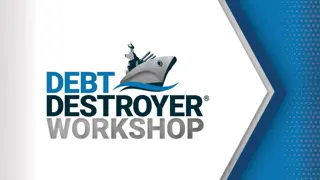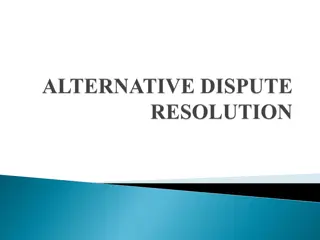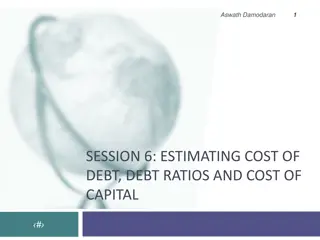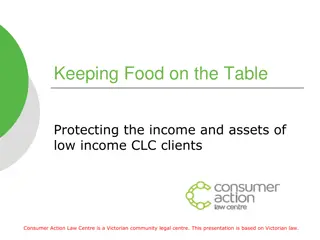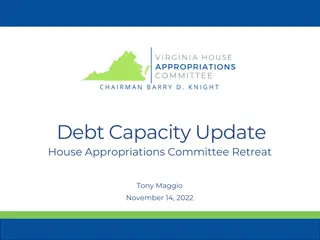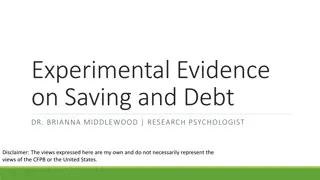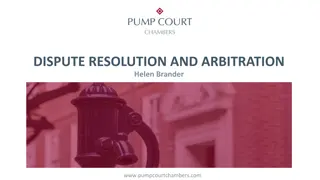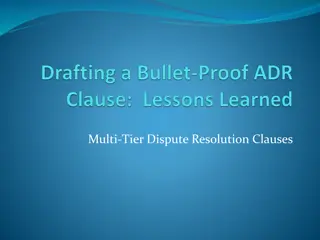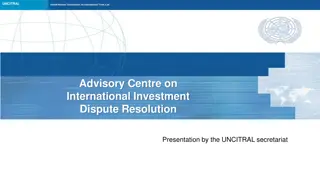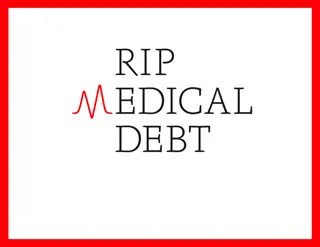Internal Dispute Resolution - Helping Clients Navigate Debt Issues
Explore the process of internal dispute resolution (IDR) to assist clients in resolving problem debts efficiently. Learn how to identify, gather information, determine issues, assess urgency, and negotiate resolutions. Discover the importance of IDR, its benefits, and who offers IDR procedures. Gain insights from a practical case study to understand how to support clients effectively in managing debt challenges.
Download Presentation

Please find below an Image/Link to download the presentation.
The content on the website is provided AS IS for your information and personal use only. It may not be sold, licensed, or shared on other websites without obtaining consent from the author. Download presentation by click this link. If you encounter any issues during the download, it is possible that the publisher has removed the file from their server.
E N D
Presentation Transcript
Help! My Client has Problem Debts #1: How to navigate internal dispute resolution
David Hofierka Credit, Debt and Consumer Law Solicitor Redfern Legal Centre
Acknowledgement Of Country
Outline Greg Story 1. Identify 2. Gather Information 3. Determine the issues 4. Assess Urgency 5. Negotiate a resolution Greg Story: The Outcome Questions and where to get more information and advice Resources: rlc.org.au/training/resources/debts
What is Internal Dispute Resolution? Referred to as IDR Internal process for consumers to resolve disputes quickly and directly Raises awareness of systemic problems
External Dispute Resolution (EDR) Internal Dispute Resolution (IDR) Court
Who has IDR procedures? Businesses that provide consumer credit and loans Insurance companies Utility providers
Greg 9
Greg story 30 years old Disability support pension Living with parents in social housing $45,000 credit card debt to big bank
Greg story (cont.) Greg comes to see you with a file full of bank statements spanning the last 10 years Repayments are unmanageable, stopping him from living independently Stress from debt is exacerbating his mental illness What would you do?
Is there problem debt? Get a list of all debts the person is aware of Ask questions shame or limited financial literacy can be barriers to disclosure of debts Rarely only one problem debt
Who is making the claim? Debtor Creditor Agent Assignment Debt Collection Agency
Request information from the debtor Any written communication from the creditor or debt collector regarding the debt, eg. bills, emails, texts, letters, default notice, letter of demand, court document Information about any verbal communication from the debtor, eg. phone calls, in person Evidence of current income, eg. pay slips, Centrelink income statement, Tax return / Business Activity Statement (BAS)
Request information from the debtor (cont.) Evidence of any health issues, .g. letter from GP, report from psychologist, test results summary Current living situation, eg. tenant, home owner, homeless Family situation, eg. any dependents , partner contributing to household expenses (or not contributing) The value of any assets, eg. motor vehicle, property, investments
Request information from the creditor / debt collector #1 Ideally request in writing Get a signed written authority to release information (some creditors have specific authority forms) Letter should identify the debtor s name, date of birth, account number / reference number (if known) Refer to alleged debt
Request information from the creditor / debt collector #2 Request the following information: Copy of the original contract / agreement Most recent bill / invoice / claim Itemised account statement summary Payout figure Any default notices sent to the client
Request information from the creditor / debt collector #3 For credit / loans from financial service provider, also request: A copy of the credit / loan application form A copy of the final credit assessment/s and verification documents Any notices under the National Credit Code previously sent to the client Details of the original limit and any limit increases on the client s credit card account including date of the limit increase
Request information from the creditor / debt collector #4 Request the documents to be provided within 30 days of the letter, and ask the creditor to refrain from taking any further legal action until 30 days after the documents requested above have been received. If the creditor is unable to make this undertaking, inform the client in writing immediately.
Red flags for legal issues #1 Expert legal advice is required to determine a legal cause of action and the prospects of success, but some obvious signs to look out for include: Client was on a Centrelink income when they were approved for a credit card / loan Client had multiple payday loans at the same time Client s bill is extremely high compared to previous bills Client has multiple loans from the same / different lenders
Red flags for legal issues #2 Client has experienced domestic violence see RLC s webinar series on financial abuse in intimate personal relationships for specific information on how to resolve debts arising from financial abuse Client does not speak English or has another significant vulnerability that was exploited by the creditor
Common Legal issues Credit Matters Grounds for a Responsible Lending complaint? Goods and Services Breach of the Australian Consumer Law? Insurer's and Motor Vehicle Accidents Is there a Defence? Is the debt 6 years old or more.
Time limit for debt recovery For most debts, a creditor must begin court action to recover the debt within 6 years of: the date that the debt first arose, or the date that the client last made a payment; or the date that the client last acknowledged in writing that they owed the debt, whichever is the most recent.
Old debt #1 If the debt is past the 6 year time limit, it is an old debt. DON T: Make a repayment Confirm in writing that client owes the debt 27
Old debt #2 DO: Get legal advice immediately Tell the debt collector/creditor that the debt is disputed because it is statute barred (more than 6 years old) Request debt collector/creditor to provide copies of the contract and account statements be careful NOT to acknowledge alleged debt, use the term alleged debt to avoid acknowledgement. 28
Financial hardship Debtor agrees they owe the money and the amount is not in dispute but cannot afford to pay Change in circumstances eg. loss of work, health problems Can occur with a legal / other dispute
Stages in a Debt Overdue Creditor chasing client Creditor or Debt Collection Agency threatening court recovery. Formal demand Court recovery commenced Statement of Claim
Stage 1: Low urgency Overdue Overdue Bill Formal Demand Reminder Letter Statement of Claim
Debt Collection Guidelines A debt collector must not: Use physical force or coercion Harass or hassle the client to an unreasonable extent Mislead or deceive the client Take unfair advantage of any vulnerability, disability or other similar circumstances affecting the client (Source: ASIC and ACCC) 33
Debt Collector Conduct As a guide, if contact is necessary, it should be limited (unless client agrees otherwise) to: A maximum of 3 phone calls or letters per week (or 10 per month) No contact on national public holidays Phone contact only 7:30am-9pm weekdays and 9am-9pm weekends Face to face contact only between 9am-9pm weekdays and weekends Home visits only if there is no other effective way of contacting client Showing up at client s workplace as a last resort if all above fails.
Avoid Debt Negotiation Firms Debt negotiation firms market themselves as professional debt negotiators , but do not need to have any qualifications, skills or training. They are not required to satisfy any particular standards or disclosure obligations to the client. This leaves the client vulnerable. Firms can charge a fee based on the percentage of amount of debt, fees can add up to thousands depending on the size of client s debt. There are free alternatives: financial counselling, Community Legal Centres or Legal Aid, National Debt Hotline in NSW.
Stage 2: Dont panic, but dont ignore Letter and/or default notice requesting full Overdue payment by a particular date Formal Demand Will threaten further recovery action if not paid May be sent from the creditor / debt Statement of Claim collector s lawyer
Stage 3: High urgency, act quickly! Overdue Statement of Claim: A document that starts a court claim Formal Demand Must be personally served on client or posted by the court Statement of Claim Creditor / Debt Collector is the plaintiff Debtor is the defendant
Stage 3: High urgency, act quickly (cont.) Overdue Client has 28 days to respond. Formal Demand If no response, after 28 days, the plaintiff can apply for default judgment. Judgment can be enforced through the court. Statement of Claim Get legal advice immediately.
What to do if your client is served with a statement of claim? 1. Defendant should get legal advice about a defence / possible settlement. 2. If the plaintiff is a member the Australian Financial Complaints Authority (AFCA), the defendant can lodge a complaint with AFCA and all enforcement action (including court proceedings) will be on hold while AFCA determines the complaint. See next webinar on External Dispute Resolution for more information about this process.
Other circumstances when your client should seek legal advice immediately! 1. The client has a judgement order against them. 2. Enforcement action has been taken against the client, for example, a garnishee order for their wages or bank account. 3. The client is required to attend court under an examination order. 4. Any court proceedings are on foot. 5. The debt is more than 6 years old.
Why it is best to avoid court Costs orders can be made against the unsuccessful party Evidence standards are higher than IDR and EDR Legal representation is expensive / unattainable for most people Stress from meeting court deadlines Loss of income from attending court Judgment order enforceable for 12 years Court enforcement options Pre and post judgment interest may be added to the debt 43
Impact on credit report New changes to Comprehensive Credit Reporting system (CCR) from 1 July 2022 Extra mandatory reporting for major banks Late or missed payments, financial hardship, contract variations will show up on credit reports Judgment debts/defaults stay on client s file for 5 years 44
Impact on credit report Repayment history will remain on credit reports for 24 months Grace period of 14 days But ..Credit reports should only reflect a person s credit worthiness If there are errors on a credit report you can assist clients to contact the financial service provider to fix them 45
Impact on credit report Don t do nothing! Encourage clients to engage in IDR Get financial counselling or legal advice Financial hardship notations remain on credit reports for 12 months Telcos and energy providers will not be able to see repayment history or financial hardship notations 46
What debts can be dealt with by IDR? Financial services are required to have in place an internal process to resolve complaints with consumers Insurance companies who have adopted the General Insurance Code of Practice are required to have an IDR process Utility providers have financial hardship teams that help customers who are struggling to pay their bills.
General process 1. Identify the IDR contact for the creditor 2. Send a written dispute / submission 3. Record the date when a response is required 4. Request a written response from creditor
General process (cont.) 5. Receive a response rejection or offer 6. Seek instructions from client 7. Negotiate further if required 8. Agree an outcome always in writing and ideally signed by both parties












